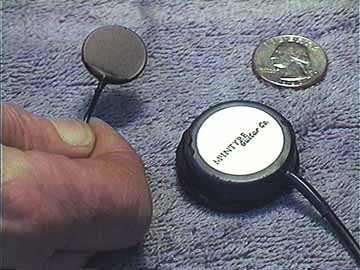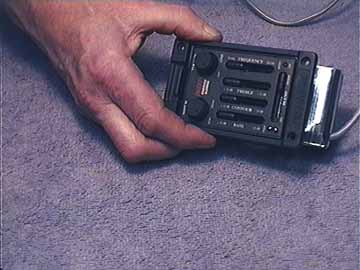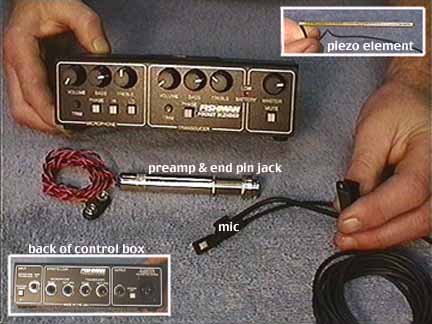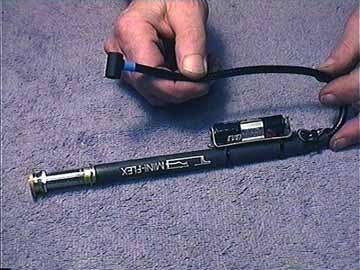From Gryphon's Mike Gold, it's a quick survey of
Acoustic Guitar Amplification
© Mike Gold, 4/10//98; Photos by FF, 4/17/98
Welcome to the wonderful world of amplifying acoustic guitars. It is a challenging
but hopefully gratifying endeavor. My aim is to help cut through some of the common
misconceptions and provide information to help figure out what is appropriate for
you.
Application, application, application!!! This is where we must start. Of course what
is fine for the weekend warrior may not be appropriate for the seasoned professional.
Let us start from the ground up:
1) Magnetic Soundhole Pickups. There are many choices available at reasonable
prices. Companies like Dean Markley, Lawrence, Seymour Duncan, Dimarzio, EMG, Sunrise
and others offer this type of pickup. They work much the same as electric guitar
pickups, sensing the movement of the string though a magnetic field. These pickups
are perfect for some one who is looking to plug in with a minimal investment and
doesn't want anything to be permanently installed.
Here is what some of them look like:

There are some things you should be aware of before running out to your local music
store. These pickups work the same way that electric guitars pickups do, consequently
they often don't sound very close to what you hear when you're not plugged in. Some
people consider soundhole pickups an eye sore. As their name implies, you mount them
in the soundhole of your guitar. If they are not wired to a “strap-jack” (further
explanation later) you'll have a wire running down the top of your axe. It's not
very attractive and can get in the way of your awesome right-hand technique.
Before you scrap the idea of this sort of pickup, let me tell you there are some
advantages. For instance, this type of pickup is the most resistant to feedback.
The awful “F” word! If playing LOUD is a priority for you this may be a good way
to go. With the exception of a couple of “high-end” magnetic pickups, they are relatively
inexpensive. There is no need to have a repair person to install it for you, again
less money to dish out.
Try as many as you can through the type of amp you'll be using. Also, not all of
them have volume controls built in. It is certainly nice to have that at your fingertip.
These generally cost less than $100.00.
2) Contact Pickups. This type of pickup can be installed temporarily on the
outside of the guitar or installed permanently inside, connected to a strap-jack.
Again, there are many companies offering this type of pickup: Fishman, Barcus-Berry
and McIntyre to name a few.

Generally, you install them on the soundboard near the bridge. It doesn't matter
whether they are mounted on the inside or outside. These pickups are generally "passive"
("active" pickups have a built-in preamp and battery power.) They greatly
benefit from being run through a preamp to boost the signal and provide some EQ.
The soundboard of your guitar resonates to produce great acoustic tone. Those same
resonant frequencies are exactly what will drive a contact pickup into feedback.
There is positive side. If you're only going play plugged in once in a blue moon,
stick one on and when you're done take it off. They are inexpensive and don't require
a “professional” installation.
3) “Under-The-Saddle" Pickups. This is the most common type of pickup
for acoustic guitars recently. Manufacturers, and guitar shops routinely install
these types of pickups in both expensive and inexpensive guitars. The cost and ease
of use, have made them very popular Companies like Fishman, L.R. Baggs,Highlander
and others make good sounding pickups in a few price ranges.
The most basic type of under the saddle pickup is a strip of piezo electric crystals
that line up below the strings. These pickups are passive (need no battery) that
generally have weak output and sound very bright. These are the type of pickups that
manufacturers put in their student level instruments to save on cost.
The next level in the food chain is a unitary sensing element (as opposed to six
individual crystals) connected to a preamp to boost, buffer and EQ the signal. This
type of pickup will have fixed volume and EQ. It runs on a nine volt battery. You
should only have to change the battery once a year, twice if you are playing a lot.
That is, if you remember to unplug the guitar when you're done amplifying it. The
preamp turns off when you unplug the instrument cable.

I want to take a moment here to describe the installation process. Some people
are hesitant to install a pickup in a fine instrument. It could affect the tone or
structural integrity. Not... I personally have installed too many to count. When
the installation is done by a qualified person it is very safe. I have never had
anyone tell me the tone of the guitar changed after the pickup has been installed.
The pickup has a small lead wire from one side. A tiny hole 3/32nds of an inch needs
to be drilled through the saddle slot, usually on the bass side. When the saddle
is in the slot, the pickup and wire are not visible. That wire either goes directly
to a jack (on passive pickups) or to a preamp that is sometimes incorporated into
a strap-jack.
The “strap-jack” replaces your strap pin on the lower bout of the guitar. To accommodate
the strap-jack, the hole where the pin was has to be reamed out slightly. On the
inside of the guitar is the end block. This is the perfect place for the jack to
go. There is zero risk of splitting or cracking the sides. The end block is very
strong. The neck block is the best place for the battery. The neck block is plenty
strong enough to support the nine volt and provides easy access through the soundhole
with slackened strings.
Click to
see me do the complete job.
Now to the sound. Tone is a very subjective thing, although, most
people would agree that the passive under-saddle pickups tend to sound very bright
and thin. The powered type have a preamp to shape the sound, and warm it up. When
the pickup is run through a preamp it is possible to go directly to some sort of
mixer, whether it be a live or recording set up.
Some people are attracted to the preamps that mount onto the side of the instrument.
They offer volume control as well as some sort of EQ. I personally am not a fan of
these systems. First of all, I don't want BIG holes cut into my instruments. Secondly,
electronics become obsolete every few years. If your preamp dies and the parts aren't
made anymore what do you do? It's very difficult to retrofit a different one, I know
from experience.
With the less intrusive installation, it is much easier to swap out pickups. Sides
can be damaged if the hole is not cut very carefully for the control unit. Generally,
the tone controls on your amp, P.A. or any outboard gear will be perform better than
the controls on a side-mount pre.
The prices on these pickups vary. . . Though the installation is not brain surgery,
it should be performed by a qualified repair person or builder, someone who is experienced
with acoustic instruments.
4) “Blender" Systems. This type of pickup uses a dual source. There are
many combinations possible, e.g. a magnetic pickup and a passive under saddle type.
Companies like Fishman, Baggs and others offer complete packages that include a saddle
pickup, a mini internal mic and preamp with a control to adjust the volume between
the two and shape the tone.
This is the unit for mounting in the side of a guitar:

It gives you all the controls at your fingertips and has its own microphone built
onto its backside.
This is a more complex and versatile outboard blender unit:

It has a higher quality microphone mounted on a flexible stalk to allow positioning
in just the right spot inside your guitar. The control box has separate effects loops
for the mic and piezo element.
Although there are many choices, the most popular combos are the internal mic and
saddle pickup systems. Microphones give the truest representation of what your guitar
actually sounds like. The problem is that: 1- The mic "listens" inside
the guitar (contrary to what your ear hears.) 2- Microphones are prone to feedback
(especially mics that reside in the guitar.) Nonetheless, you can get very good results
if you use the mic sparingly.
Again, these system should be installed by an experienced person. My inspiration
for learning how to work on instruments, was born out of a less than satisfactory
installation on one of my guitars several years ago. For recording there is no
substitute for a high end external condenser microphone by Neumann, AKG etc...
When making a decision like this, it is very important to seek out the nearest reputable
acoustic shop. Ask your friends. Do some research. Find out who does the best work
in the area you live. Tell them very specifically your application and I'm sure you'll
be able to come up with something that sounds good. The prices range from about $100.00
to over $1000.00 which indicates the range of possible combinations.
Although it's not strictly speaking a "pickup," an internal microphone
like this one can also be used alone to produce a fine acoustic tone:

Once you think you know what kind of pickup system you'll be installing in your guitar,
it is very important to try it through the type of amp you'll be playing it through.
If you're going to be running your “Fishman Matrix” into a Fender Twin, demo the
pickup through an electric guitar amp. This will give you a more realistic representation
of what it will sound like in your rig.
Most of these pickups will sound best going through a good PA or a dedicated acoustic
guitar amp.
I work at Gryphon Stringed Instruments in Palo Alto, CA. Please call me at 650-493-2131
if I can be of any help.
Back to Index Page